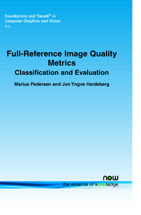Full-Reference Image Quality Metrics: Classification and Evaluation
By Marius Pedersen, Gjøvik University College, Norwegian Color Research Laboratory, Norway, marius.pedersen@hig.no | Jon Yngve Hardeberg, Gjøvik University College, Norwegian Color Research Laboratory, Norway, jon.hardeberg@hig.no
Abstract
The wide variety of distortions that images are subject to during acquisition, processing, storage, and reproduction can degrade their perceived quality. Since subjective evaluation is time-consuming, expensive, and resource-intensive, objective methods of evaluation have been proposed. One type of these methods, image quality (IQ) metrics, have become very popular and new metrics are proposed continuously. This paper aims to give a survey of one class of metrics, full-reference IQ metrics. First, these IQ metrics were classified into different groups. Second, further IQ metrics from each group were selected and evaluated against six state-of-the-art IQ databases.
Full-Reference Image Quality Metrics
Images are subject to a wide variety of distortions during acquisition, processing, storage, and reproduction. These distortions can degrade their perceived quality. Since subjective evaluation is time-consuming, expensive, and resource intensive, objective methods of evaluation have been proposed. One such method, image quality metrics, has become very popular and new metrics are continuously being proposed.
This short book provides a survey of one particular class of metrics, full-reference image quality metrics. It starts by classifying image quality metrics into four groups: mathematically based metrics, low-level metrics, high-level metrics, and other metrics. It goes on to explain selected image quality metrics from each group in detail. Similarities and differences between the metrics are then discussed. This classification is helpful for understanding the foundation on which the metrics were created. Further image quality metrics from each group are then selected and evaluated against six state-of-the-art image quality databases. This evaluation of full-reference image quality metrics is one of the most extensive carried out in the literature and makes the text an invaluable reference for students and researchers in the imaging field.
